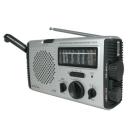The shifting of the Caribbean tectonic plate that caused Haiti’s tragic double-earthquake provides an opportunity for insight into the shifting realities of communications technology, authority and power.
When major news corporations like CNN lost contact with Haiti and were unable to provide any information, images posted on Facebook by ordinary “nonprofessionals” were the first to be broadcast. The social networking platform has also been used by Zynga games to raise $1.5 million for relief. Some of the earthquake victims have been able to contact rescuers via text messages and texting has also been used as a powerful fund raising instrument, raising $22 million.
These positive and potent applications of the latest digital technology are challenging old hierarchies, empowering new voices and inspiring fresh approaches. However, in our excitement over the potential of these new tools, we would be wise to remember their vulnerability and ongoing relevance and utility of elder technologies. It may be that our most intelligent and advanced approach to technology would be a thoughtful, selective hybrid of the new and the old.
While technologies like texting and Facebook rely on complicated and relatively vulnerable systems, a radio can be run by battery. Shortwave radio in particular has historically been effective for broadcasting in emergency situations, especially since its signal can reach any point on earth by using the ionosphere as a reflector. Because of this reliability and relative stability, shortwave radio is also a part of our technological response to the tragedy in Haiti. A group called Ears to Our World (ETOW) is providing shortwave radios for isolated Haitian survivors.
These are some of the shifting realities of human communication….and it all started with writing.


